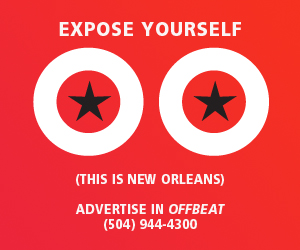The Voodoo Experience has been in a constant state of evolution since it first hit the New Orleans scene back in 1999. From its first incarnation as a single day event at Tad Gormley Stadium, to its triumphant post-Katrina return and its acquisition by music industry powerhouse Live Nation, the annual gathering has undergone myriad changes over the years.
One of the most recent major adjustments to the festival’s character came in 2010, when the Voodoo Experience announced that its dedicated electronic music stage would be revived under the Le Plur moniker. In the years since, the stage—which derives its name from the classic raver mantra of Peace, Love, Unity and Respect—has become one of Voodoo’s most popular attractions.
“What we’ve been seeing is that a lot of people go to that stage and then they don’t leave,” says Voodoo Experience founder and Live Nation executive Stephen Rehage. “Since we brought it back in 2010, it’s been as big as the main stage.”
The revival of Le Plur came at just the right time. Since 2010, electronic dance music—or EDM—has exploded across the country. Once considered an international phenomenon with a niche presence in the United States, EDM is now firmly rooted in the mainstream of American music.
A glance at the 2015 Voodoo Experience lineup finds some of the biggest DJs and producers in the electronic music universe listed right below heavy metal icon Ozzy Osbourne, country mainstays the Zac Brown Band and indie darlings Florence + the Machine. Their names might not ring any bells for the 30-plus crowd, but you would have a hard time finding a college student today who isn’t familiar with Skrillex and Diplo (a.k.a. Voodoo headliner Jack Ü) or progressive house pioneer Deadmau5. Instruments or not, these are some of the most popular touring acts in the world.
While some old school Voodoo fans lament what they see as the festival’s growing focus on electronic acts, the complaint is unfounded in a lot of ways. EDM has been a part of the festival’s DNA since the start, if Moby’s headlining slot at the inaugural event is any indication. However, he was a bit of an outlier, one of the few DJs to break through into the mainstream during that era. Most of the electronic artists were buried deep at the bottom of early Voodoo lineups.
“I think, if you look historically, it’s always been a key element of Voodoo,” explains Rehage. “Look back at the lineups and you’ll see all these guys were playing before the larger audience got into them. I wouldn’t say it’s something that we’ve recently jumped on. The audience has grown naturally over the past few years.”
Peruse through some of the earlier Voodoo lineups and you’ll find a superstar like A-Trak listed in the very last slot (2001) or legendary producers like RJD2 and LTJ Bukem hidden in what might as well be fine print (2003). Electronic artists may not have been the most popular acts on the bill, but Voodoo showcased more of them than most festivals in those days. Of course, that should come as no surprise considering the strength of the New Orleans rave scene at the time.
“There was a ‘DJ stage’ from year one,” recalls Rehage. “New Orleans always did have a great scene with Disco Donnie and all the stuff he was doing at the State Palace. He actually used to book the stage for us. We didn’t bring it back after Katrina, and from 2005 to 2010, there was a conscious effort to gear the money toward New Orleans musicians. Then we brought the old concept back, which was Le Plur.”
While the sight of wide-eyed teenagers in bright neon clothes losing their proverbial shit in front of an all-but-seizure-inducing light show may shock, or even annoy, the average Pearl Jam fan, the old and new have more in common than most people realize. The EDM world of 2015 is, in a lot of ways, quite similar to the alternative rock world of 1999. Once considered the purview of nonconformists and those in-the-know, electronic music has since graduated from the underground to become positively… normal. It might not be all the rage a decade from now, but there’s little doubt that it will be an important part of the fabric of Voodoo for many years to come.
“Voodoo was always supposed to be something that had no rules or genres. If you look back at the first year, it really was all over the place,” says Rehage. “Who knows where all of it goes? What matters is that it’s great live music. That’s the important thing.”




